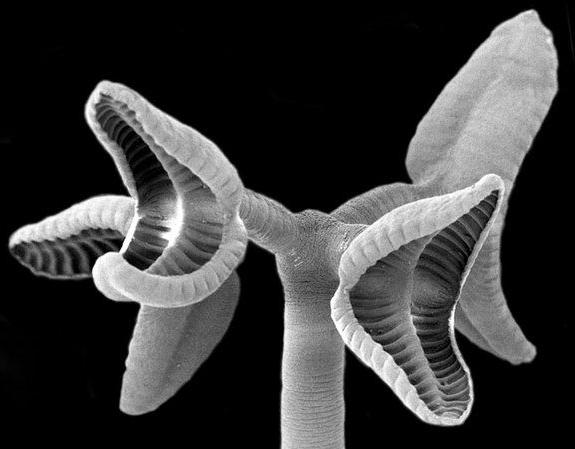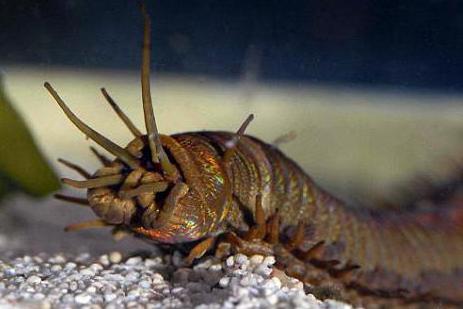All representatives of multicellular animals differ in the level of organization, characteristic features of life processes and are combined into special taxa - types. There are a total of 7. Type flatworms is one of them. These creatures are perfectly adapted to the conditions of existence and occupy their biological niche. How do flatworms feed? Look for answers in our article.
General characteristics of flatworms
Representatives of this systematic group got their name due to the shape of the body. The cross section of flatworms resembles a leaf or tape. These animals are characterized by bilateral symmetry and formed organ systems. The musculoskeletal system is represented by a musculocutaneous sac, which consists of a integumentary epithelium and several layers of muscles. The excretory system consists of thin tubules that open outward in pores.
The vast majority of flatworms are hermaphrodites, but some can reproduce vegetatively. In parasitic species, a change of owners is observed in the life cycle - final and intermediate. The nervous system consists of the central and peripheral parts. But flatworms do not have respiratory organs and carry out gas exchange through the entire surface of the body.
Habitat
Among these animals, both parasitic and free-living species are found, which determines the nutrition of flatworms. They can be found in the seas, fresh water, and very rarely on land in tropical forests.
Parasitic species live in the intestines and liver of many animals: cattle, pigs, dogs, cats and even sperm whales. Some dangerous species live in the human body.
Digestive system
The digestive system of flatworms is a closed type. It consists of the mouth and intestines. How are flatworms fed? Food particles enter through the mouth, are digested in the ramified intestines, and residues are also removed through an opening located on the front end of the body.
The feeding of flatworms, which lead a parasitic lifestyle, occurs at the expense of the host organism. In such species , the digestive system is completely absent . Already digested substances they absorb through the integument.
Eating flatworms
Worms that live in various bodies of water are predators. They attack small benthic animals and, using a special proboscis, suck out their contents.
The nutrition of flatworms and roundworms is somewhat different, since the latter have a digestive system of a through type. It looks like a tube with a mouth and anus, so their metabolism is more intense. Free-living terrestrial flatworms feed on insect larvae living in moist forest litter.
Ciliary worms
Representatives of this class of animals live in water. In this environment, epithelial cells secrete a special secret that helps to keep small benthic animals - crustaceans, hydras, and various larvae. Eating flatworms of this class is very unusual.
For example, in a milky-white planaria, the mouth opening is located in the middle of the body on its ventral side. The worm creeps on the victim, thus holding it. Then, a proboscis protrudes through the mouth opening, with the help of which the planaria sucks the liquid contents from the body of the prey.
Flukes
What do flatworms that are parasites eat? Let's consider this question on an example of a class of flukes. They got their name due to the presence of suction cups. Usually there are two: oral and abdominal. With their help, parasites attach to the internal organs of the host.
These worms in the course of their development go through a rather complicated life cycle. For example, the eggs of the hepatic trematode first together with the undigested leftover food of cattle fall into the water, and from there - into the body of the mollusks, where tailed larvae develop, which again enter the water. Settling on plants, they turn into cysts. Cattle, the ultimate host of the parasite, become infected when they drink water or eat grass. In his body, a cyst begins to grow and develop into an adult, the size of which reaches 3 cm.

It is at this stage that the worm feeds. At the bottom of the first suction cup is a mouth opening that opens into the intestines. The digestive system has the form of a bag or two channels that end blindly. Since these helminths lack a body cavity and circulatory system, the gastrointestinal tract also performs the function of supplying the whole body with various substances. Flukes feed on blood, mucus and epithelial cells. Helminth exchange products are secreted through the mouth opening, while poisoning the body of the final host.
Tapeworms
Representatives of this class are characterized by a complete absence of the digestive system. This trait is related to their lifestyle. On the head of tapeworms there are special attachment organs. They can serve as suckers, hooks or proboscis. With their help, parasites attach to the walls of the small intestine. Already partially digested substances they absorb the entire surface of the body, so they do not need the digestive system.
Tapeworms pose a serious danger to a person who is both an intermediate and final host for them. Absorbing a large amount of nutrients and vitamins, the parasite grows rapidly, sometimes reaching gigantic proportions. For example, bull and pork tapeworms grow up to 10 meters. Eating substances intended for humans, parasites quickly deplete their body. In this case, the host is also poisoned by the products of the exchange of worms. A person infected with helminths experiences weakness, dizziness, nausea, lack of appetite and even loss of consciousness.

So, what flatworms eat depends on their environment and way of life. These conditions also determine the structural features of their digestive system. This type of animal combines 3 classes: ciliary, tapeworms and flukes. The former are free-living predators that prey on smaller animals in ponds. Flukes are parasites that attach to internal organs and feed on foods and tissues. Tapeworms are devoid of the digestive system. These parasites live in the lumen of the small intestines of animals and humans, eating already digested particles of food.